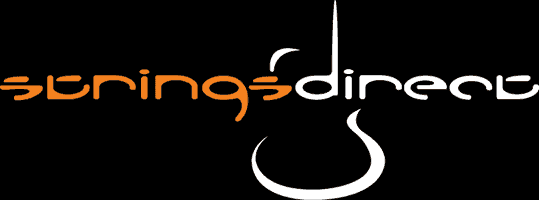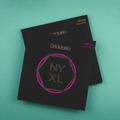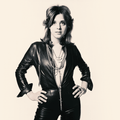Guitar Slides of the Blues Greats
By Strings Direct – 29 August, 2023

The world of guitar slides is not easy to navigate. As is often the case with guitar gear, when it comes to picking the right guitar slide, there is an overwhelming amount of choice. Not only do slides come in different shapes, sizes and thicknesses; they are all made from different materials.
Each of these elements affects their tone and playability, and as such they are important to consider. In my last article I covered the fundamentals of guitar slides. I explored the different shapes, sizes and materials from which slides are made and how these different elements affect both tone and playability.
If you are new to the world of guitar slides, I would recommend heading over to that article before continuing here. However, to further help with your search, in this article I will be looking at the guitar slides used by some of the greatest slide guitarists of all time.
This is partly for academic interest. I love to learn about the gear that different guitarists use, and the impact that this has on their tone. More importantly though, I hope the information outlined here helps you to choose the right guitar slide for your setup. For whenever you are thinking about buying a new piece of gear - be it something as small and inexpensive as a new pick, or as significant as a new guitar - I think it is always useful to look to your heroes for inspiration.
And whilst copying your blues guitar heroes certainly doesn't guarantee that you will be able to create killer blues tones, it will set you on the right path.
Here then I have compiled a list of some of the most notable slide guitarists of all time. I have categorised guitarists by the type of slide they play. I have detailed the type of guitar slide they use(d) and where possible I have linked to specific slides, or similar slides that will help you to recreate the setup of any given player.
So whether you are trying to recreate the tone of your favourite slide player, or you are just looking for inspiration more broadly, I hope the information in this article helps.
Here are the guitar slides used by some of the best slide guitarists of all time:
Metal Guitar Slides
Metal guitar slides have been used since the early days of the Delta blues. Guitarists often used the blade of a knife or a flat piece of metal to slide up and down their strings. And metal has since remained popular amongst guitarists that are looking for a sharper and more aggressive blues guitar tone. Just some of the many notable slide guitarists who have used metal guitar slides are as follows:
- Robert Johnson. Although much of Robert Johnson's life remains shrouded in mystery, it is believed that he played using a metal guitar slide, which he wore on his fourth finger. In recent years, Robert Johnson’s estate has commissioned slides made from bronze, which is not a particularly common material for this purpose. The good news though, is that traditional metal slides will help you to get close to Johnson’s searing slide tones. Slides like the Jim Dunlop 224 Brass Slide or the Jim Dunlop 222 Solid Brass Slide would both make a great choice.
- Elmore James. Surprisingly, there is not a lot of information about the slide setup of Elmore James - ‘The King of the slide guitar’. Having said that, James was heavily inspired by Robert Johnson. As noted above, Johnson used a metal slide. And so I suspect that James did the same. This would not be surprising, as his slide guitar tone is bright with a lot of treble and bite. One of the slides linked above, or a chrome slide, like the Dunlop 220 Chromed Steel Slide or the Dunlop 228 Chromed Brass Slide would work well here.
- Muddy Waters. Like many of the early Delta bluesmen, Muddy Waters used a metal guitar slide. He had a small slide which he wore on his fourth finger. Although the exact material of Waters’ slide is not known, a slide like the Ernie Ball Chrome Plated Brass Slide could work very well.
- Johnny Winter used a lightweight chrome guitar slide which he wore on his fourth finger. This gave his tone a sharp and aggressive bite, and allowed him to execute licks and solos at speed. Winter has a signature slide - the Johnny Winter Texas Slide. So if you want to recreate Winter's searing slide tone, that would be my top choice.
- Rory Gallagher. In his early career, Rory Gallagher always played with a brass guitar slide. He paired this up with a Fender Telecaster to produce a very sharp and biting slide tone. As such, if you want to recreate Gallagher’s killer slide tones I would recommend a brass slide like the Jim Dunlop 224 Brass Slide or the Jim Dunlop 222 Solid Brass Slide. The Rock Slide Aged Brass Slide would also make a great choice if you are looking for a boutique option.
- Joe Bonamassa. When he plays slide guitar, Joe Bonamassa uses a chrome guitar slide, which he wears on his third finger. He did have his own signature guitar slide, although this no longer appears to be in production. As such, if you want to recreate Bonamassa’s fiery slide tones, I would recommend opting for a chrome guitar slide. The Johnny Winter Texas Slide would work well, as would the Dunlop 220 Chromed Steel Slide or the Dunlop 228 Chromed Brass Slide.
Glass
Like metal, slides made from glass have been popular amongst blues guitarists since the early days of the Delta blues. At that time, guitarists would use the neck of a glass bottle to slide up and down their strings. And it is for this reason that slide guitar is often referred to as ‘bottleneck’ style. Some of the notable blues and blues rock guitarists to use glass slides are as follows:
-
Duane Allman famously used a glass Coricidin medicine bottle for his guitar slide. Allman’s legacy is such that many of the glass slides out there are designed in the style of his Coricidin medicine bottle. If you are looking for a glass slide and you are interested in authenticity, then Dunlop offers the Derek Trucks Signature Slide.
Heavily inspired by Allman, Derek Trucks also plays with a glass slide, and his signature slide is modelled precisely on Allman’s Coricidin bottle. It is the same weight and is closed at the top. It also has the same indent at the bottom of the guitar slide where the lid for the medicine bottle would have originally been. If you are looking for something in a slightly lower price range, then Dunlop also have a range of similar ‘Blues Bottle Guitar Slides'. -
Ry Cooder. Throughout his career, Ry Cooder has been fairly reticent when it comes to discussing the nuances of his technique and setup. As a result, the exact guitar slide he uses is unclear. Having said that, when Cooder plays electric guitar, he uses a glass slide, which is quite heavily flared at the top. He has also spoken about his preference for heavy walled slides. As such, I would recommend looking at the Jim Dunlop 235 Flare Glass Slide if you want to recreate Cooder’s setup.
-
Sonny Landreth. Slide guitar virtuoso Sonny Landreth uses a Dunlop Glass Slide with heavy walls. Like Ry Cooder, he initially played using a flared guitar slide. And he did so because this allowed him to use a specific vibrato technique. However he later switched to a straight slide, because in his own words - 'a lot of what I do is around the 12th fret and I use all six strings, so having that straight edge is a lot more helpful'.
- Gary Clark Jr. Like Derek Trucks, modern blues guitarist Gary Clark Jr. has a signature guitar slide. His is also made of glass but differs from Trucks’ in two ways. Firstly, it is not a 'Blues Bottle' slide, and so it is not closed at the top, nor does it have an indent at the bottom. Secondly, Clark Jr's slide has a very heavy wall. If you want to recreate the sound of Clark Jr's slide playing, his signature slide would be a great place to start. Beyond that, a thick glass guitar slide would also work well.
- Warren Haynes was initially inspired to play slide guitar by musicians like Duane Allman, Lowell George and Ry Cooder. Like Allman, Haynes initially played slide using a Coricidin bottle. However he later swapped this for an open-topped glass guitar slide. Apparently the specific slide Haynes uses is the Dunlop 215 Glass Guitar Slide. This is a long slide with quite a heavy wall. So if you want to sound like Haynes, then opting for that specific slide, or for one similar to it would be a great choice.
Porcelain and ceramic
Porcelain and ceramic have only been used in more recent years in the manufacture of guitar slides. As such, their use within the blues genre is not as extensive compared with slides made from glass or metal. Having said that, they have proven popular with a number of famous blues and blues rock guitarists. This is because of their balanced and well rounded tone and feel. Some of the most notable guitarists to use porcelain and ceramic slides are as follows:
-
Billy Gibbons. During his career, Billy Gibbons has used slides from a variety of different materials, including porcelain. His signature slide - the Rev Willy's Mexican Lottery Brand Mo-Jo Porcelain Slide - would make a great choice if you are looking to recreate Gibbons’ slide setup.
-
Joe Perry. Like Billy Gibbons, Joe Perry also has his own ceramic signature slide - the ‘Boneyard Mudslide’. This comes in short, medium and long lengths - giving you the option to choose a guitar slide that either covers half or the whole of your finger. Perry wears his slide on his third finger.
-
Keb’ Mo’. To create his beautiful and varied slide guitar tones, Keb' Mo' uses his own signature guitar slide, which he wears on his fourth finger. If you are looking for a similar tone and feel but you don’t want to opt for Mo’s signature slide, then either the Jim Dunlop Moonshine Slide or the Jim Dunlop Mudslide would also work well.
- Samantha Fish. Although she has more recently started using brass slides, modern blues guitarist Samantha Fish used to play with a heavy-walled ceramic slide. If you want to recreate Fish’s slide setup, a slide like the Jim Dunlop Mudslide would work well.
Putting it all together
From an academic point of view, I think it is interesting to have a greater understanding of the different guitar slides that all of these players use(d). But the real aim here is to help you choose a guitar slide that will work well for your playing style and setup.
Thankfully, I think that for the most part the slides used by the guitarists listed here are not that surprising when you consider the tonal properties of the different slides they use. Broadly speaking, the guitarists that play a more aggressive and intense style of blues with a sharper guitar tone use metal guitar slides. And those with a more mellow style and a warmer tone favour glass slides.
There are some notable exceptions to this of course. Ariel Posen and Joey Landreth are two modern slide players who both play metal guitar slides (they each have their own signature Rock Slides) and yet they both play a more mellow style of music that blends a variety of genres. Duane Allman played a glass slide, and yet a lot of his slide playing is fiery and intense with a real bite.
This is because - as you might expect - the slide that you play does not limit you to a particular style or sound. Certain slides can bring out different elements in your playing. And if you want to create tones at the extremes of the tonal spectrum, opting for one slide over another makes sense.
If for example you want to dial in a very sharp and biting tone, a metal slide makes a good choice. Conversely, if you are looking for a very warm and mellow tone, you might struggle to create that tone without a glass slide.
It is also worth noting that you don't need to limit yourself to just one slide. Guitar slides are relatively inexpensive. And so there is no reason that you can't buy a number of different slides. This will allow you to create tones from a range of different guitarists. And if you have more than one guitar, then it also gives you the option to use different guitar slides with different instruments.
Compared to guitars, amps and pedals, guitar slides are relatively inexpensive. Even if you were to go wild and buy 10 guitar slides for your collection, you could do so for less than £200. I appreciate this is still a decent chunk of money. But it is cheaper than buying just one boutique guitar pedal.
If you want to recreate the tones of a number of the different slide guitarists listed above, this could be a great option. And whilst you can of course create different tones with a single guitar slide, you might have more success (and fun) playing with a range of different slides.
Whichever approach you take, just remember to keep playability front of mind. Buying guitar gear is all about finding the sweet spot between tone and playability. And most importantly, it is about figuring out what works best for you.
Do this, and use the setup of your favourite slide players as a guide, and you will be well on your way to finding the perfect guitar slide!
* * * * *
ABOUT THE AUTHOR

The Happy Bluesman
www.happybluesman.com
@happybluesman









